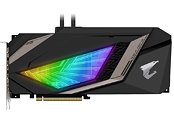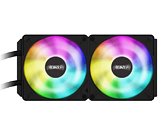Monday, November 26th 2018

GIGABYTE Intros GeForce RTX 2080 Ti Aorus WaterForce Xtreme AIO
GIGABYTE debuted liquid-cooled WaterForce editions of its Aorus Xtreme GeForce RTX 20-series graphics cards early November, with three products, two based on the RTX 2080, and one RTX 2080 Ti. While the RTX 2080 got two variants, one featuring an AIO liquid cooling solution, and another with a full-coverage water-block for DIY liquid cooling; the RTX 2080 Ti at the time only released in the full-coverage water-block trim, with no variant that has an AIO CLC. GIGABYTE changed that today, with the new "N208TAORUSX W-11GC," or Aorus GeForce RTX 2080 Ti Xtreme WaterForce.
This card features a slightly spruced up version of the Asetek-sourced AIO closed-loop liquid cooling solution its RTX 2080-based sibling features, with a larger base-plate to draw heat from the additional memory chips and MOSFETs that come with the RTX 2080 Ti. The card features the same factory-overclock as the water-block equipped twin, with a GPU Boost frequency set at 1770 MHz (vs. 1545 MHz reference). The memory is overclocked to 10140 MHz (GDDR6-effective, vs. 14000 MHz reference). The cooler features RGB LED embellishments along the front, top, back-plate, and the two included 120 mm fans for the radiator. It draws power from a pair of 8-pin PCIe power connectors. Display outputs include three each of HDMI 2.0b and DisplayPort 1.4, and a VirtualLink port. The card could be priced upward of $1,400.
This card features a slightly spruced up version of the Asetek-sourced AIO closed-loop liquid cooling solution its RTX 2080-based sibling features, with a larger base-plate to draw heat from the additional memory chips and MOSFETs that come with the RTX 2080 Ti. The card features the same factory-overclock as the water-block equipped twin, with a GPU Boost frequency set at 1770 MHz (vs. 1545 MHz reference). The memory is overclocked to 10140 MHz (GDDR6-effective, vs. 14000 MHz reference). The cooler features RGB LED embellishments along the front, top, back-plate, and the two included 120 mm fans for the radiator. It draws power from a pair of 8-pin PCIe power connectors. Display outputs include three each of HDMI 2.0b and DisplayPort 1.4, and a VirtualLink port. The card could be priced upward of $1,400.





8 Comments on GIGABYTE Intros GeForce RTX 2080 Ti Aorus WaterForce Xtreme AIO
I'm not sure if I find that card a mess or hideous... It's definitely not my cup of tea.... :(
2080ti is Voltage locked
even on stock AIR you can OC a card to the highest the manufacturer allows the voltage to be boosted and you card will still be running under 70degrees
adding a waterblock doesn't provide anything except it will run cooler (no performance increase whatsoever)
so this is just a ploy to make people rack 1500$ instead of 1200 lol
Sure, custom loops will always be available, but I like that the pump and reservoir are integrated into AIO units, simplifying space and mounting; furthermore, the CPU is an easy part to cool silently with moderate clocks on an air cooler which also does a better job of providing airflow to the VRM and RAM area.
I think it's interesting that Gigabyte opted for a 240mm this tier because it limits the chassis and mounting options while likely providing the same performance.
MSI's Seahawk EK X w/ the WB made by EK has been the sound choice since it's introduction so good to see Giga following suit ... but MSI's habit of using the PCB from lower level air cooled units kinda quashed it's even if price wise it was great (significantly less than purchasing separately bu $30-50) ... I mean if ya gonna slap on a premium quality WB from market leader EK on a high end GFX card why slap it on the low budget card ?
I imagine we can assume, as in the past, it's better than the EVGA variants and, at least on the AIO model it appears uses a high end PCB .... but I'd like to know....
1. Who made the FCWB ?
2. And what PCB did that slap the FCWB on ?
3. Which GPU .... "A" model or the one ya don't want ?
BTW, as to GFX card AIO's being "unrivaled", that's not at all true. Yes, certainly, the Full Cover water blocks version are extremely quiet when used with properly sized rads and fans (< 40C) but the single fan AIO models with cheap aluminum rads are usually within +/- 1 dbA of the air cooled model with the same PCB. Not that sellers don't try an make you thinks so. The tests aren't exactly "apples and apples" and intentionally so. We see below that the MSI Seahawk AIO is 1C cooler than the Gamer X air cooled model and that's why the hybrid card is clocked substantially lower .... to sell you on the idea that it's quieter. To bad it isn't.
www.guru3d.com/articles_pages/msi_geforce_gtx_1080_sea_hawk_x_review,11.html
The card noise levels in the tests are measured out of the box, now one would think that the AIOs comes out of the box with higher core clocks being water cooled and all. However .... the AIO Seahawk comes out with Core clocks of:
1569 MHz (OC Mode)
1544 MHz (Gaming Mode )
1480 MHz (Silent Mode)
And the Gaming X air cooled model comes outta the box with
1708 MHz (OC Mode)
1683 MHz (Gaming Mode)
1607 MHz (Silent Mode)
Obviously with 9% faster core, the card is going to generate more heat and fans will have to spin faster.
More importantly, like every AIO on the market, it violates the 1st law of water cooling ... ***never mix metals in the loop***, Your saddled forever with a cheap aluminum radiator that cause galvanic corrosion. Won't go into the science, or dare show you the pics .... nerdy geek types experience physical symptoms while viewing ... but its all here:
martinsliquidlab.wordpress.com/2012/01/24/corrosion-explored/
To avoid the above, if ya don't want a custom loop grab a Swiftech (or EK) AIO and the FCWB option from your choice card vendor.